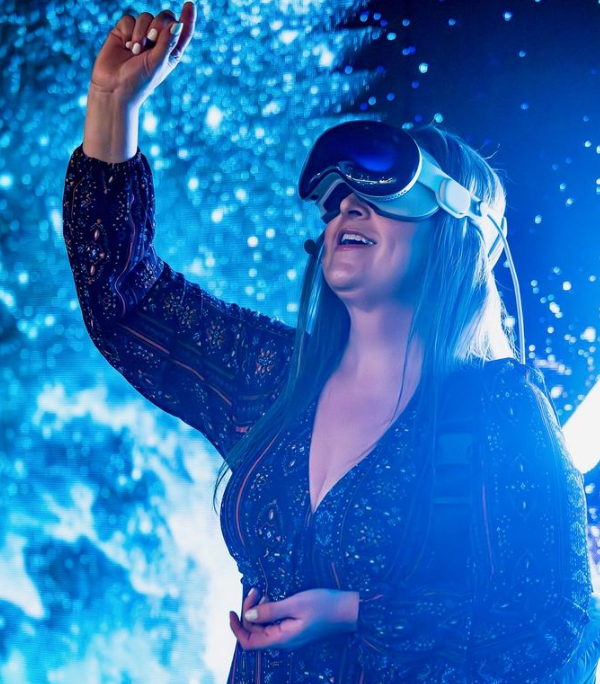Spatial computing isn’t here just yet but it’s coming and we need to be prepared. Globally-reputed tech futurist, Cathy Hackl, tells us more in an exclusive interview about the new hardware.
The first time most people heard the term ‘spatial computing’ was when Apple unveiled its Vision Pro headset. With a hefty price tag and limited availability, this futuristic piece of technology quickly got everyone talking. Who would buy an Apple Vision Pro? Is it not just another virtual reality (VR) headset?

“Most people don’t understand what spatial computing is,” says Cathy Hackl, a tech futurist and author who is often referred to as the ‘Godmother of the Metaverse’. “It is not one piece of hardware or one single technology.” Hackl explains that spatial computing isn’t VR or augmented reality (AR), it’s the future. “We are seeing an expansion of computing and an evolution of the web happening side-by-side. The convergence of all of these emerging technologies happening at the same time? That’s spatial computing.”
The computing evolution
Computing has already gone through an evolution so the fact that there’s something new shouldn’t come as a sur- prise. First, there were big, expensive mainframe com- puters that most people didn’t have access to. This was followed by the personal computer, a desktop that sat at your home or work.
Loading...
“It was the first time that many of us engaged with a computer,” says Hackl. What followed next was mobile computing. Portable laptops and smartphones “and we now have a supercomputer in our hands that we don’t go anywhere without”, she adds. “What we’re starting to see now are other kinds of devices like facial computers, AI companions, smart glasses… but at the same time, the web is evolving. There was first the worldwide web which was followed by the mobile web and now we’re going into the spatial web – the metaverse.”
When you combine these three elements – advanced computing, spatial internet and new hardware being created – what you come out with is spatial computing. “It’s a 3D-centric form of computing that at its core uses AI computer vision, extended reality and a multitude of technologies to start to blend virtual content and experi- ences into someone’s experience of the physical world,” Hackl says, adding that spatial computing will not only alter human-to-human communication but also human- to-computer interaction.
And you can see this shift starting to happen with large language models (LLMs) and generative artificial intelligence (genAI). “For many years we have been adapting to technology but this time, it’s
technology starting to adapt to us,” she says. “Spatial computing will result in new interfaces, software, hardware, data types and levels of connectivity. It’s not simply VR or the Vision Pro – that’s re- ductive and limiting.
A new interface
Hackl anticipates that in the next 12 to 18 months, we’re going to see new hardware thrown at us – attempts at new form factors, new ways for people to interface with technology. She says that there will be big advancements in audio and smart glasses and although the mobile phone isn’t going anywhere just yet, there is a new form factor coming.
There are already companies like Magic Leap that are focusing on building spatial computing devices for the enterprise. Partnering with a mining company, they used their Magic Leap 2 headset as a worker training tool, overlaying key data into the physical world for immer- sive, real-time guidance. “With spatial computing, the physical world becomes the interface and that in itself is revolutionary,” says Hackl. “I think, in general, people are ill-prepared for what’s about to come.”
What’s next, says Hackl, is that we’ll be able to access data through spatial computing devices. “Accessing that data layer will be a huge step in human computer inter- action and it’s going to allow for more robots and autono- mous vehicles,” she says. AI plays a crucial role in this because in order to make use of big data, information has to be processed in real-time. This is how robots navigate the physical world; they use spatial intelligence and large action models (LAMs). The difference between a LLM and a LAM is that LAMs go beyond language by under- standing user intentions. LAMs can perform complex tasks through direct interactions with various applica- tions and systems.
Convergence, not AI
Although Hackl insists that spatial computing is still years away, we need to be ready for its impact. The line between the physical and virtual world has already starting to disap- pear if you take into account what people are spending their money on. For the generation coming up, virtual assets (like buying Robux, Roblox’ in-game currency) already have more value than physical assets. To reach this demographic, companies like Walmart have created entire worlds inside Roblox where an item purchased in-store will have a digital twin inside the game. Hackl, who was Walmart’s metaverse advisor in-residence, helped them with this project: “They’re starting to think about this new customer who wants to consume content as well as products and services.”
To prepare for spatial computing, Hackl advises that businesses don’t buy a hundred Apple Vision Pros. While it is what she calls an ‘early’ spatial computer, the headset will evolve and other technology brands will follow. “A couple of decades ago AI was in this evolu- tionary phase and now it’s revolutionary. Spatial com- puting is now evolutionary but it will be revolutionary,” says Hackl. “AI seems to be the word of the year but I think it should be convergence because that’s what we’re truly seeing – a convergence of all of these incred- ible technologies.”
Loading...
